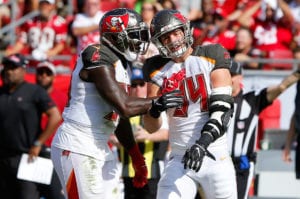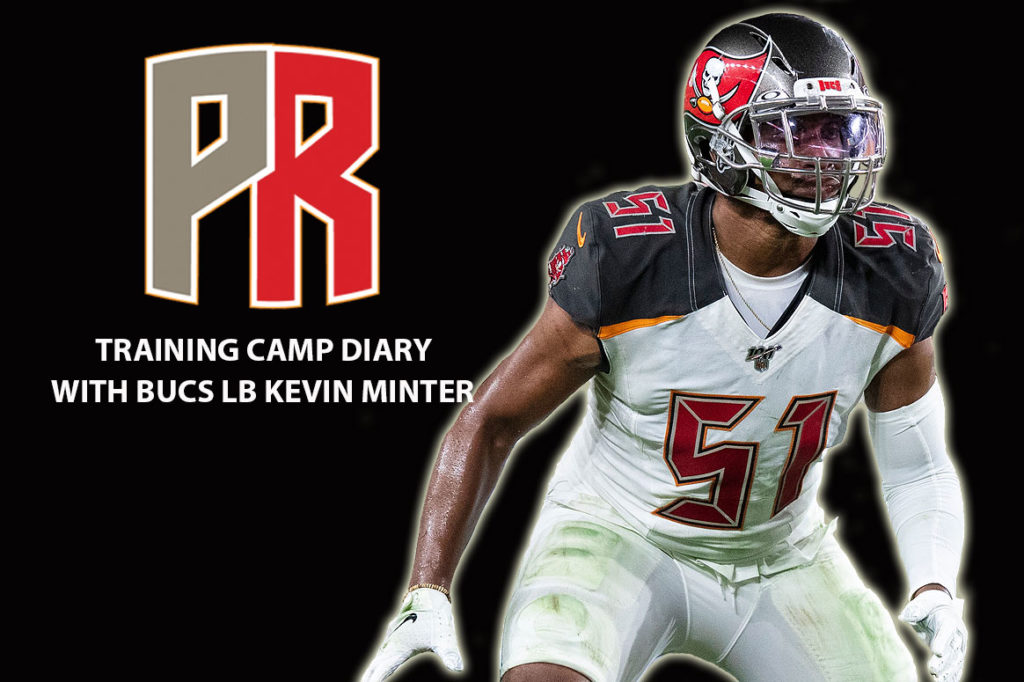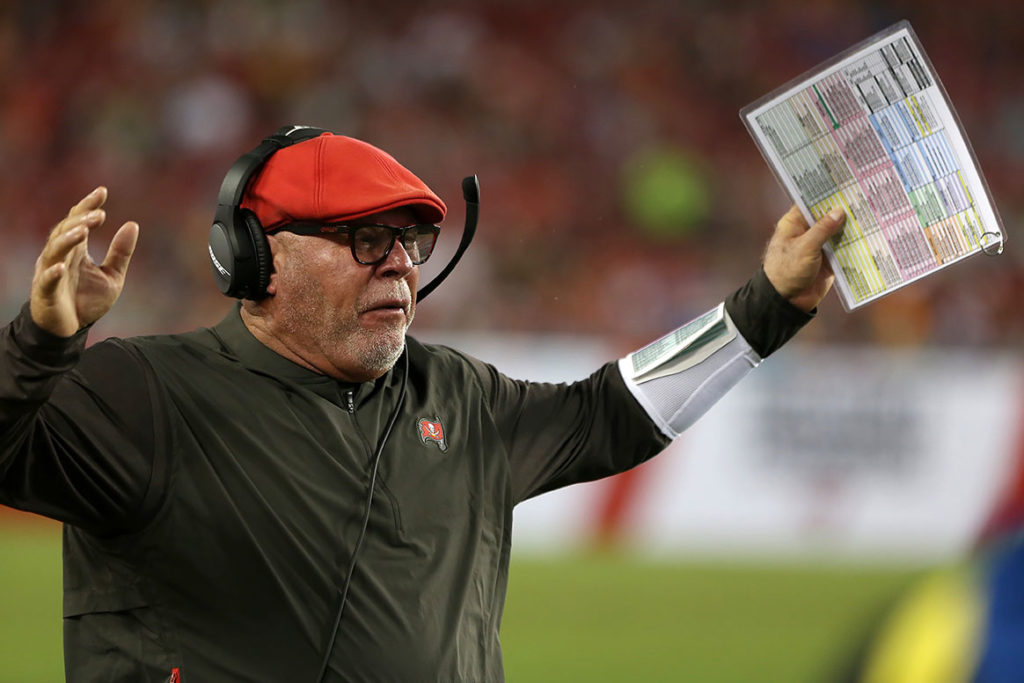All-Twenty Tuesday: Bowles’ Preseason Pressure
In today’s age of football, the 3-4 defense can take on many shapes. Since it requires less defensive line players with their hands in the dirt (meaning rushing from a three-point stance with a hand down on the ground as opposed to them just standing up in a two-point stance with both hands off the ground), it allows for more flexibility and placement of players before the snap.
The player with the most variance is the added outside linebacker. In a 4-3, there are four players with their hands in the dirt; two defensive ends and two defensive tackles. In a 3-4 there are only three players with their hands in the dirt; this can be aligned to have two defensive tackles and one defensive end or two defensive ends and one defensive tackle. However, due to the fact that defensive fronts don’t want to give up too much size and impact on the trenches in the run game, that fourth player, even without their hand on the ground, is usually still close to the line of scrimmage and rushing off the edge.
The Bucs had five sacks against the Dolphins last Friday night, and four of those came from edge-rushing outside linebackers Shaquil Barrett, Devante Bond, Demone Harris and Farrington Hugenin.

Bucs OLBs Jason Pierre-Paul and Carl Nassib – Photo by: Cliff Welch/PR
The 3-4 outside linebacker position has many different forms it can take on. Just like the traditional 4-3 linebacker position names like MIKE (middle), SAM (strongside) and WILL (weakside), the new outside rusher – who is technically a linebacker – has its own position names.
Each name you could call the fourth linebacker identifies what it could be in a 3-4, and throughout Buccaneers defensive coordinator Todd Bowles has used all three names, as I would identify them. Technically, each coach can call this position whatever they want, but over the years I have come to categorize them in the following manner, as to detail what defenses are doing in clearer form.
There are three specific titles that can but used to characterize the emphasis rush player in a 3-4 defense. Each of them falls at a different point of the size range of about 6-foot-2 to 6-foot-5 and 230 pounds to 260 pounds. Now, as stated before, there are plenty of coaches who use these terms interchangeably. Depending on who you ask, all of these titles might mean all the same thing to certain coaches – these could all be the names you choose to call the same player. But, as I’ve learned about each, I feel like I’ve picked up little characteristics of each name that allow me to split them up into three different titles to help explain things a bit better.
This isn’t a universal way to describe the position, but I think it’s pretty helpful in identifying where a 3-4 defense may turn to for its strength, since it can be so customizable.
“LEO” Pass Rusher
The first way to describe such a pass rusher is by labeling them a “LEO.” In football, position terminology revolves around alliterations. Remember MIKE is Middle, SAM is Strong side, WILL is Weakside.
A LEO is a combination of the words Linebacker and Defensive End.
As the origin of its name suggests, a LEO is a hybrid position. It revolves around a player who can play both linebacker (two-point stance) and a defensive end (three-point stance). But, as I have studied NFL and college defenses over the years, I would say that a LEO is more of a linebacker who does most of his work rushing from two-point stance. I also think these 3-4 rushers are more about speed than power. When New York Jets pass rusher Jordan Jenkins led the team in sacks in 2018, he did so from a role I would consider a LEO role.
http://www.giphy.com/gifs/U6GwDnG6FY53HcAZeY
As shown in the clip above, Jenkins, who was at the top of the defensive line, came off the ball from a two-point stance (standing up with no hand on the ground). He may have won with an inside move, but that didn’t mean he didn’t win with speed.
The Jets defense under Bowles and defensive coordinator Kacy Rodgers, who is the Bucs defensive line coach, constantly aligned Jenkins in a wide-9 position, meaning he was at least a step outside the offensive tackle’s outside shoulder. This allows for players with speed to usually get to the outside and bend the pocket.
http://www.giphy.com/gifs/JRPXRkmZ9AA0Be6Uix
The clip above was an even better example of that. In it, Jenkins was rushing from a wide-9 position yet again on the bottom of your screen, but this time he used his extra space to get deeper down the pocket and beat his man with a speed rush into the quarterback.
LEO can mean different things to different coordinators, but to me I see it as the more speed-type player in a 3-4 defensive front. Jenkins is about 6-foot-3, 245 pounds, and that is the size of a guy who could play with his hand in the ground, but his best work will likely be standing up.
If Bowles wants to get a LEO role out of this defense, I think it would come from Noah Spence.
http://www.giphy.com/gifs/Z9nvEXoDF67DZEHBwE
In the Bucs first game against Pittsburgh, we saw Spence get a lot of playing time in that LEO role. Yes, Spence went pretty untouched in the clip above, but he went untouched because of the alignment he was in and the speed he had off the snap. That offensive lineman had no chance getting to him from that wide-9 look. That was the plan.
http://www.giphy.com/gifs/ZbfIg6uek9wLvnYerG
Just like Jenkins flashed in the examples above, when Spence can hit his inside move from a wide alignment, he can be a real handful for offensive linemen.
Spence hasn’t mastered that inside move yet, and there were times in the Dolphins game where the offensive tackles were daring him to go inside and he didn’t. If offensive tackles are going to sell out to counter his speed around the edge, he has to get better at recognizing the space between the tackle and guard and hitting it like he did in the clip above.
If he can do that, he can be an effective LEO for Tampa Bay who racks up sacks with speed.
“JACK” Pass Rusher
The next 3-4 rush specialist I want to explain is what I would call a JACK. This position gets its name from being described as a “Jack-of-all-trades.” The thought process here is that not only can this linebacker hybrid rush from a two-point AND three-point stance, but that they can also be asked to slide inside as an interior rusher and even drop back into coverage a bit.
During Bowles’ tenure as a defensive coordinator throughout the league, I wouldn’t say he’s had the “perfect” example of a JACK, but the closest one is likely the man who led his 2014 Arizona Cardinals team in sacks, Alex Okafor.
http://www.giphy.com/gifs/UnyF3VH1Y0DnFlO7iD
Though the nature of the JACK title hints that you can play them in any alignment, unless you have a true freak of nature as your JACK, you’re going to have alignment preferences. Since Okafor was bigger at 6-foot-4, 260 pounds, he played more of a 7-technique, which is right off the outside shoulder of the offensive tackle, instead of what a LEO would be, which is further to the outside.
As seen in the clip above, Okafor was a player who used his power more than speed, even from a two-point stance.
http://www.giphy.com/gifs/YqhJsCuXUIE6eJ2AmM
Part of what makes a JACK a JACK is your ability to kick them inside. Okafor was still lined up as the outside edge player in the clip above, but his rush was right at the right guard, not the right tackle. In doing so, he bull-rushed the guard straight back and into the pocket. Potential interior disruption, whether with power or speed, is a characteristic of a good JACK. You have to have the size and strength to do so.
http://www.giphy.com/gifs/cmMuq3gZn92h1Afe1x
As noted before, sometimes JACK linebackers will even be asked to help out in the passing game. Okafor wasn’t in a pure drop-back role in the clip above, but what makes him a “Jack-of-all-trades” is that he can affect the game in a positive way in different manners at any given time. That includes keeping your eyes up when your rush is beat and either batting passes down, dropping back into coverage or even getting takeaways.
Of the players on the Buccaneers who have played a good amount of time in the preseason, the two players who I could see utilized in this role would be either Shaq Barrett or Carl Nassib.
http://www.giphy.com/gifs/UUsg2kdXbmQ5A9LTlZ
At 6-foot-2, 250 pounds, Barrett could also play a LEO role well, if Spence can’t become that guy (or even if they just wanted to switch it up on certain plays). But, in Barrett’s most productive season in Denver, he recorded 5.5 sacks, got eight tackles for loss, forced four fumbles and defended four passes. Those are JACK-like stats.
http://www.giphy.com/gifs/daJIBjSKtomoJYraMf
The Bucs used Nassib in a ton of different ways last year. They had him line up outside in a two and three-point stance, inside as a 4-tech, and as a coverage dropping linebacker. Remember when Nassib covered downfield and broke up a pass on third down against Cleveland?
Sounds like a JACK, huh?
Nassib is 6-foot-6, 275 pounds, which is bigger than a normal 3-4 linebacker. But that wouldn’t stop Bowles from using him in a JACK role, if he can play all the cards.
“BUCK” Pass Rusher
The final 3-4 priority linebacker position I want to introduce is the BUCK position.
If we go back to the alliteration connection with position titles, BUCK represents your Best player. A BUCK linebacker has to be strong enough to set the edge, fast enough to make tackles in the back field, skilled enough to get around the edge, but most importantly, smart enough to always know what to do and be one step ahead.
That was John Abraham in his 11.5 sacks season as a 35-year-old in 2013 for Bowles.
http://www.giphy.com/gifs/SxASRkXrKa345PX7vG
The veteran Abraham just knew how to dissect a pocket in 2013. Whether it was reading run plays to the outside, pass rushing from the edge or making moves inside and overpowering linemen, Abraham had so many clips that made it look like it was so easy.
http://www.giphy.com/gifs/J6Uno0d3hfyhVAGQSc
As stated before, what goes into being a BUCK linebacker isn’t just having the talent to win off the line in multiple ways, but also knowing what to expect. When Pierre-Paul was on the field for the Buccaneers last season, identifying him as their best defensive lineman was easy.
One of those examples is shown above. From his years of experience in the league, Pierre-Paul’s snap count anticipation can sometimes be scary good. Pairing that with his athletic ability is a recipe for tackles in the backfield.
http://www.giphy.com/gifs/Rfe5wKErK3aetlEMgL
Another way Pierre-Paul shows off his savviness is when forcing fumbles. In the clip above, Pierre-Paul saw the opportunity to get more than just a sack; he saw the chance to get a takeaway. Pierre-Paul is constantly hunting for the best play to make, not just the one right in front of him. That’s part of what makes you a BUCK kind of player in a 3-4.
LEOS, JACKS and BUCKS are all types of outside linebackers that will play in Bowles’ 3-4 scheme in Tampa Bay – whether they be lined up as a SAM (strongside outside linebacker) or a WILL (weakside outside linebacker). Because of his athleticism and playing style, Pierre-Paul is a BUCK/LEO-type linebacker.
In the two clips I showed, Pierre-Paul exemplified speed off the edge, power on the inside, effectiveness with his hand in the ground, effectiveness from a stand up position, and with all that, the football IQ to make the best play at any time.
That’s what could make him the best player for this new Bucs defense – whenever he’s medically cleared to play this season.
That’s what Bowles and company will need this season, at some point. They need a hero, and a healthy JPP could be that guy.



